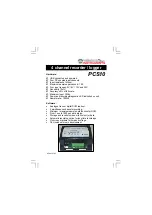
CB-50 Deployment
Single point mooring
Single-point moorings are used in calm waters when monitoring sensors are
attached to the instrument cage or housed in deployment pipes. The sensors are
thus protected and less vulnerable to damage caused by subsurface debris, high
currents, and entanglement from anchor lines.
In a single-point configuration, a stainless steel mooring line connects the buoy
directly to a bottom chain and anchor. At normal pool/stage, the mooring line
should be taut, with most of the bottom chain resting on the seafloor. As the
water level increases and the buoy rises, the bottom chain is lifted from the floor.
Important:
This section contains only general information on the available
mooring options for CB-50 data buoys. To develop an effective mooring strategy, a
variety of application-specific criteria (water level fluctuations, currents and wave
action, debris loads, etc.) must be thoroughly reviewed prior to deployment.
NexSens does not endorse any particular mooring strategy for any specific
application.



























